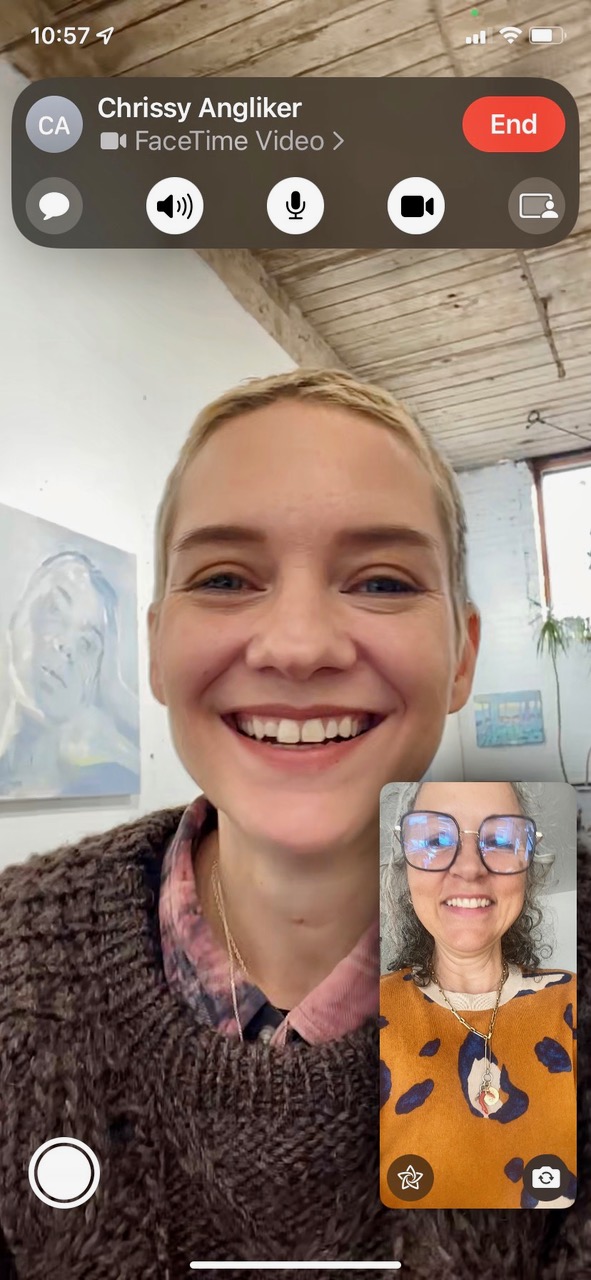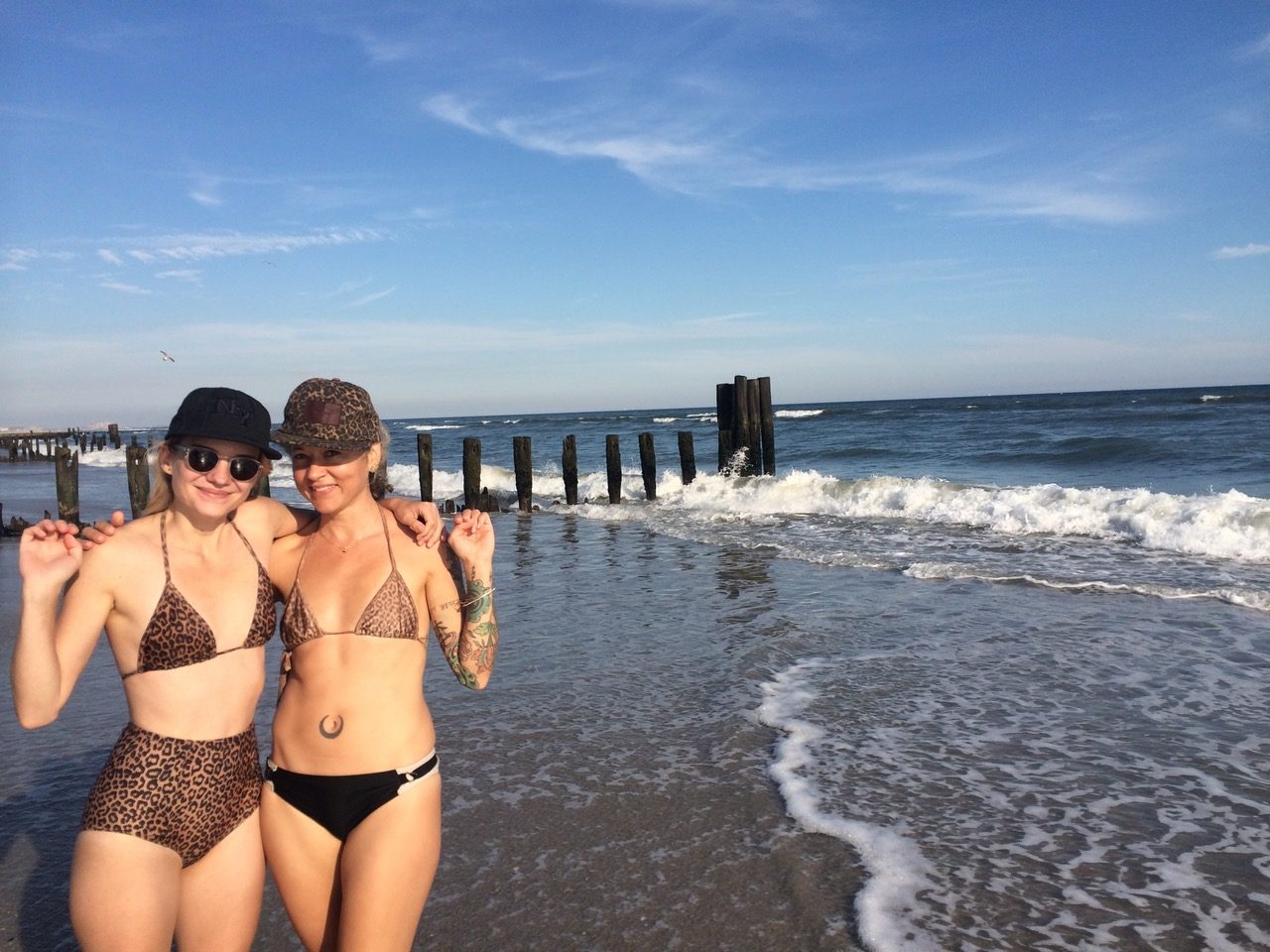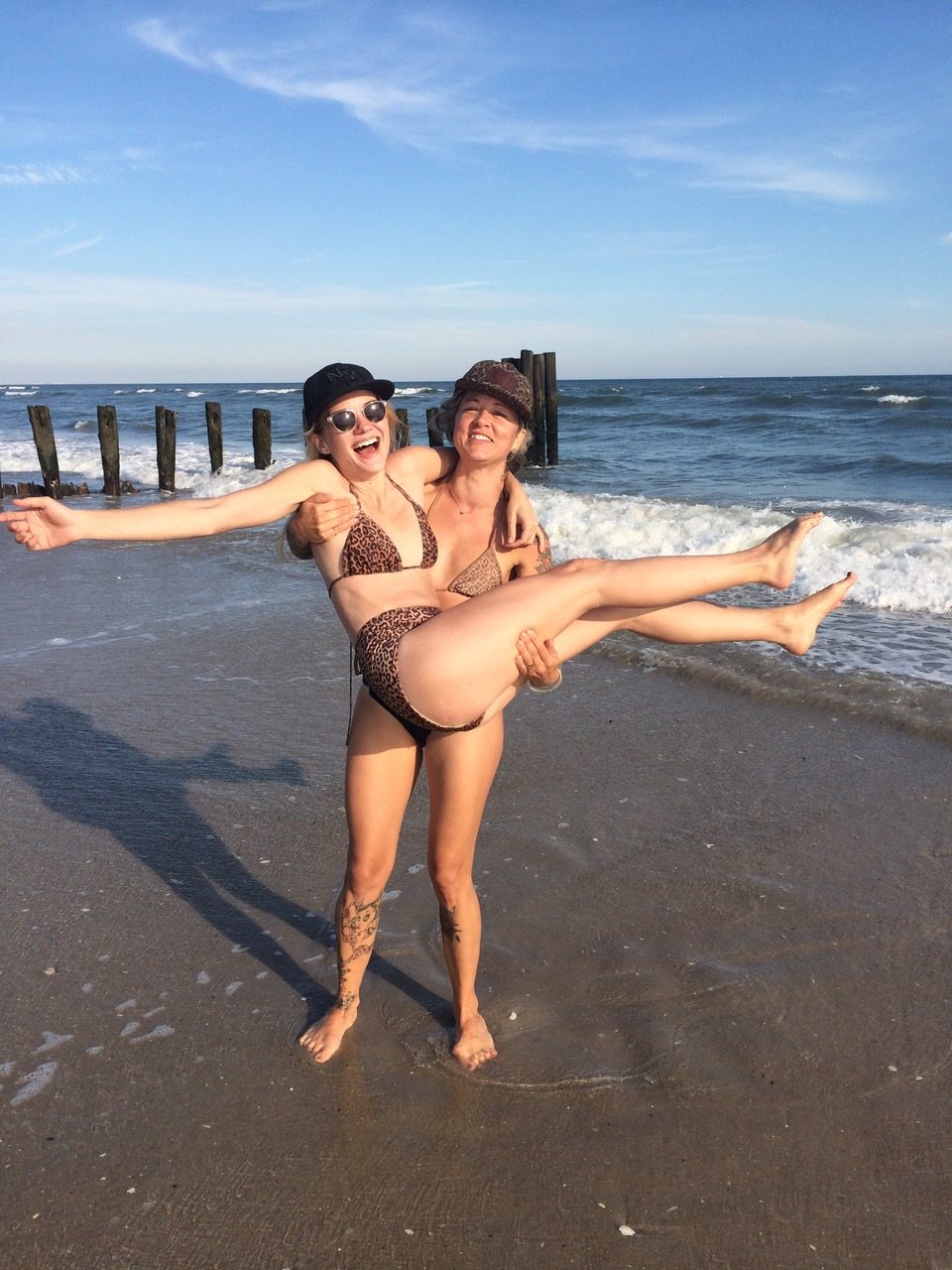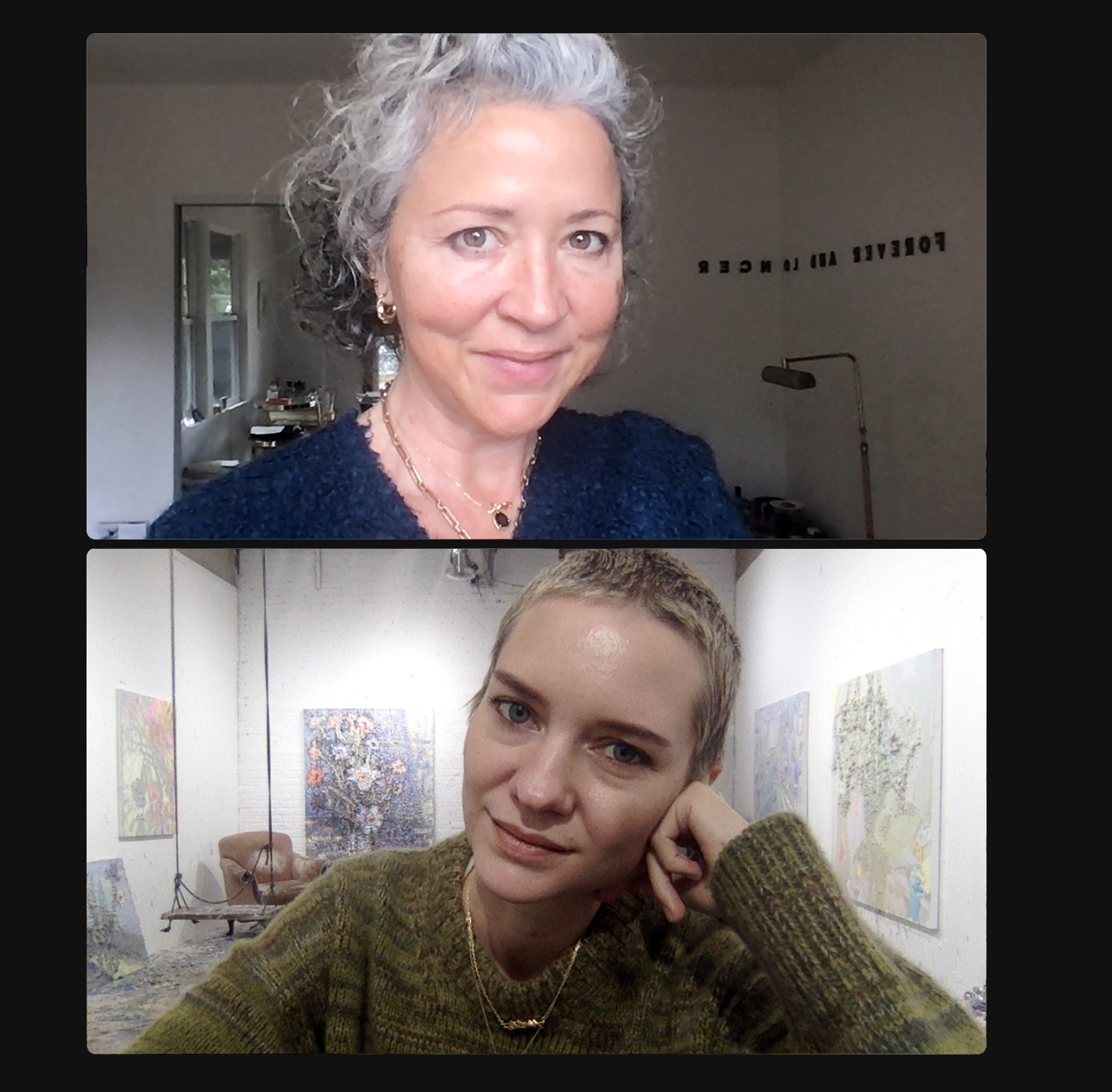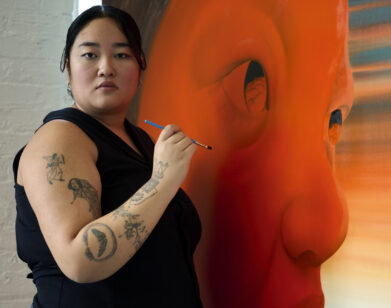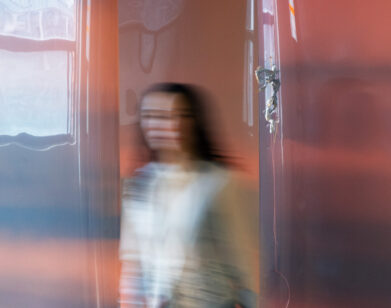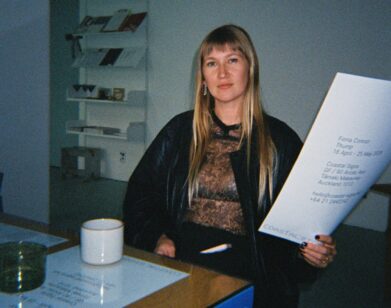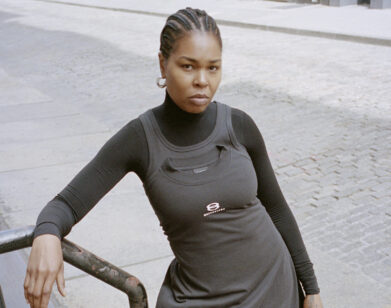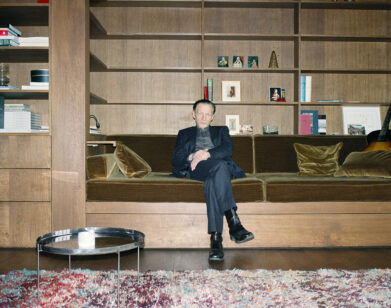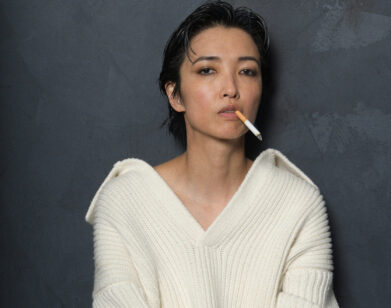in conversation
Chrissy Angliker and Anna Sheffield Are High on Tulips
Buying art is not a purely democratic process. Galleries are intimidating—sterilized boxes oftentimes void of emotion. And for the Brooklyn-based, Swiss-American artist Chrissy Angliker, the afterlife of her rich and dynamic paintings—that is, the buying and selling that constitutes what we call the “art market”—is as much a part of her process as the creation of the works itself, as she explains to her longtime friend, the jewelry designer Anna Sheffield. Though Angliker has lived in New York for some 20 years now, she doesn’t see herself as a local, per se. Which is why she trusts Sheffield, who she considers a “quintessential New Yorker,” as she enters the New York art scene. Angliker, whose paintings of the natural world and bodies of water burst with texture (sometimes she paints with spoons) has for years shown her work across the U.S. and Europe. Now, she’s settling into the city in which she resides. It started earlier this year with an exhibition at Massey Klein Gallery; then, in November, she became one of the first artists to make her work available for purchase on PLATFORM, the newly formed, digital e-commerce art store backed by David Zwirner. The site promises to equalize the playing field for buyers, a world that’s often gate kept by the super-wealthy and connected, and in the process pair first-time collectors with emerging artists at reasonable price points. Below, the two artists and friends have a conversation about the prevalence of nature in their work, the importance of sharing art with friends, and that one spring they were “high on tulips.”
———
SHEFFIELD: Hi.
ANGLIKER: Where are you?
SHEFFIELD: I’m back in L.A. The hardest part, I was trying to decide, “Should I take this call in my office, next to my altar in my living room, at the kitchen table?”
ANGLIKER: I was like, “Oh, I’ll do it at home maybe,” and send Mike to the office. There’s crazy construction outside now, so I came here. My studio neighbor was having a meeting, and it was all loud. They left just in time, and so now it’s all perfect.
SHEFFIELD: Ask, and the universe will provide.
ANGLIKER: Cool. Well, here we are.
SHEFFIELD: I’m so excited to talk to you. Well, for one, just having a call with you on my calendar was the biggest treat ever. Oh, God. It’s so funny. I love how our conversations meander, and it’s such an amazing, wonderful, weird synchronicity that we would come together on something like this to interview each other. Which I think is absolutely magical. Well, I’m sure it’ll be circuitous. I’m sure we’ll talk about lots of interesting things, but I was thinking maybe we should start with how we met because it sets the stage for serendipity as a theme. I want to hear your version because I literally just told my version the other day.
ANGLIKER: Well, in 2014, right?
SHEFFIELD: I think so.
ANGLIKER: In 2014, I think it was a Sunday. I was hungover, and I was going to the coffee shop. I was getting my little chai tea, or whatever was going to fix it. And then Nicholas [Morgenstern] walks in, and he’s like, “Well, what are you doing in five minutes?” I’m like, “Nothing,” and then he’s like, “Well, can you go and grab your swimsuit, and then meet me here in five minutes? I’m going to pick up my friend.” That’s all he said. I had no excuse, and I was like, “Be spontaneous.” So I went and got it, and then the car pulls up. It’s you and—
SHEFFIELD: Marc (Aguilar).
ANGLIKER: You’re already in the car, and we take off. It was like getting in a blind date’s car.
SHEFFIELD: It was so awesome. I loved that, the whole way that it worked, and I actually wore this shirt in honor of it. Probably subconsciously, though. The best part was seeing this adorable, smiling, gorgeous person get into the car, and thinking, “Oh, wow. We’re going to really get to know each other today at the beach. How fun.” We got there and took off our clothes, and we were both wearing leopard swimsuits. It was amazing.
ANGLIKER: It’s like a blind date. Chuckle. Chuckle.
SHEFFIELD: That was the moment when everything else fell away, and it was just you and I talking. Digging deep, going through all the conversations. Every single time we meet and talk it’s like, elevator-deep.
ANGLIKER: It always starts with a cute little moment, and then it’s like, “Oh, and now let’s take it all the way down.”
SHEFFIELD: I love that so much. Getting ready for this, I was thinking about some of the conversations that we’ve had lately, “Oh, remember that time we were having wine, and then we talked about nature?” I was thinking about some of those things, and going back to early conversations that we had. Finding those common places where we touch down over and over again. I was thinking a lot about that. The fact that we’re both from places where nature is so prevalent and so omnipresent. How we both reference that so much in everything that we do, but we also were so deeply “city,” and would end up in a car at Rockaway in a leopard bikini on a drunk or hungover Sunday.
ANGLIKER: Yeah.
SHEFFIELD: I’d love to hear, today, some of the things that we reference when we talk about where we’re from.
ANGLIKER: We both have this thing in common, that we’re from more of a nature-y place. I grew up in Switzerland, and nature was way more prevalent there than in Brooklyn. It’s still so surreal to me that I’m in New York because I never thought of myself as a big-city person. Also, when I’m in nature, I just feel more natural. At the same time, I try to find nature in the city. Not in the one tree that’s on the corner, but in the objects. Finding nature in how things are created, and finding nature within human interaction. And figuring out, in conjunction with city life, where I feel most natural, or where do things flow most. You’re one of these people that I really associate with New York, even though you’re in L.A. now. You’re so quintessential New York to me.
SHEFFIELD: Oh, thank you.
ANGLIKER: It’s like you bring your nature. I love how you see things. I love how you translate things in such a natural way and, to me, that’s where nature gets filtered in the city. I feel like that’s what we also have in our conversation. So it’s not the trees, it’s the nature between us.
SHEFFIELD: There’s something deeper. I love to take notes after our conversations, which is crazy. I love you talking about nature, and saying that there’s this discourse that we have with nature. That becomes part of who you are and then it informs that sort of discourse that you have with others and becomes this driving of force. And also, this sense of commonality that we have. When I was in New Mexico this past week and it snowed, one of the first things I thought was, “Oh my god, I can’t wait for Chrissy to come here someday and paint this.” I want to see how you see it because we can converse about it. I want to see the language and the distillation of what happens when you put it through your art because you’re the only person that I’ve ever seen that would paint snow with red. She’s a genius.
ANGLIKER: There’s the muse, and it’s really that moment when it hits you. You got to feel it, and then you act upon it. I feel like that’s something that, from the get-go when we met, we have very similar timing when it comes to the need to translate the things that emotionally hit us. We’re both very sensitive and then we disappear and go make something about it because we got to translate it. That also segues into how we had the synchronicity of the tulips. I think that was also in 2014 when we had the tulips as our muse.
SHEFFIELD: Yes.
ANGLIKER: You were like, “Chrissy, what are you inspired by right now?” And then I was like, “What about you?” And we were like, “Tulips!” At the same time, because we react so fast, we get to show each other the fruits of our translation—what this muse is to each other in real time. Whenever we connect and talk about things, go through things, or have new projects, there’s always an alignment because our tempo is very similar. With some other friends, sometimes it’s like, “Oh, they incubate longer.” But I feel like that’s something that we have very in common, that axis of when it hits you and when it needs to be translated.
SHEFFIELD: Absolutely. I think that was one of the deeper and more immediate subjects that came up. Where we were both finding this incredible contact with a muse. So it felt random. I mean, I think it was the spring time, but other than that it could have been any flower. What you called it was being high on tulips, which I loved.
ANGLIKER: Yeah.
SHEFFIELD: We’ve talked so much about art. One of the things that I find so remarkable is your way of putting into words these things. Talking about the muse, or talking about the painting. Talking about art and its channel. That was one of those really eye-opening moments for me in getting to know you, when you had started to put together your book and when you explained to me the title [PAINT/ING/S]. That it was the paint, the painting, and the paintings. The fact that you could break it down like that between the medium, the act of being the conduit, and then the result. It’s not just about the subject of the work. You have this much deeper way that you’re rooted in your art, which I love because it takes you from in between that space of being just fully taken over by the art, but then also being able to sit with someone and put it into words. I think one of my notes was you saying that there’s this sincerity in the moment of discovering when you’re making art. This deep connection that happens, and just how completely sincere and quiet that can be. I want you to talk a little bit about that.
ANGLIKER: Oh, yeah. That segues into you tapping into art right now.
SHEFFIELD: Well, I’m a little behind the eight ball on that. You’re the one that’s been doing it so long. I’m the one that’s always like, “No, I’m not really an artist. I just make jewelry. I stopped making art years ago.”
ANGLIKER: Yeah. You can’t always be making art, but you can always be an artist.
SHEFFIELD: I guess it counts. Not the same as you, though. You’re so pure with it. You paint every day. You’re driven. Look at your beautiful studio behind you. You take something so visual and then transform it into these layers and layers of… it’s almost like cake icing. Not to mention I adore you for painting with spoons. Does the world know that you paint with spoons? And that I come to your studio, and pick them up off the floor, and save them?
ANGLIKER: I have more for you if you want. The context that goes into the curation of your stores that are total fucking gems. What I’ve always loved about how you work is you collaborate with other artists and people. How you can create synergy so easily with other people. It’s a healthy, organic feedback loop that is part of your business, and to me, working like that is really creative. Doubling today. [Points at her Anna Sheffield jewelry]
SHEFFIELD: You’re doubling up. I love it.
ANGLIKER: Hustle and hand.
SHEFFIELD: Double talismans.
ANGLIKER: That is the whole context of how everything sticks together. I feel like you’ve inspired me so much. Again, having these events at the store, or the way you connect people through your jewelry. That’s an art form, and that’s something so beautiful. It’s a way of life, running a business like that.
SHEFFIELD: We talk about that a lot. There’s that axis of how you can be an artist, but then to also have a business mind. These things are diametrically opposed, but you can find some sort of cadence that allows you to dip back and forth between them. And even with your art, to get to go from the visual to the verbal, which is how you could take your painting and make a book that really elicits that full sensation of being with you while you ideate. I appreciate that you see the jewelry in that way. That you see that I have maniacal attention to detail. Not just in the pieces, but in how they’re displayed.
ANGLIKER: There’s one thing of having an idea and talking about an idea, but then it’s not really real. It’s the whole effort of actually making something, then putting it into the world.
SHEFFIELD: I mean, we keep saying the “hustle,” which is our internal phrase. It’s that idea of integrating those two—the space of the esoteric, the art, the purity, and then where it hits the world. And how you have to get in there, and hustle it, and whip it into something fantastical, like a meringue.
ANGLIKER: We’re really into discovery. Why would you discover something and then not want to learn from it? And integrate it into your life? What’s the point, then? So, again, creating is this discovery mode. And then from there, you keep going on.
SHEFFIELD: Well, I think that’s also how we get so in that way. You get to a level of manifestation. That’s where the witchy side of it comes in too because I remember, was it two years ago? We went to Ten Bells for wine, we went so deep that night. That was one of the nights where as soon as I left you, I wrote down so many things that we had talked about, and ways that you had described things. But I remember that night you saying how you’ve been making art in New York City. And in so many ways, this art is born of that interaction with you and New York City. But then you were showing it so much in Europe and wanted to find that right fit to show it in New York. And then boom, a year later, you have a solo show, and now PLATFORM. That was such a magical interaction between you and the work. As soon as you throw that out, it goes into that boomerang of New York wicked wisdom, and it comes back to you fully formed.
ANGLIKER: Sometimes I also feel like saying things out loud to you helps. You were the one that I showed the mockup of the book to in 2016 to just be like, “Sensei, what do you think?” For certain things, I feel like, “Oh, I’ve got to announce it to this person,” because then I’m announcing it to myself.
SHEFFIELD: Yep.
ANGLIKER: Again, in my head you’re my quintessential New Yorker. I started to have this dynamic where I come to New York, which is my home for 20 years now. I come here to incubate, completely incubate, create, and then they leave. I leave with them, go have shows, go have fun, come back, lock it down, and work again. It’s this shift of like, “Well, I can make it here, and then also show it here again.” Because you follow wherever the art is doing well. But there was this moment where I’m like, “I really want to give art to New York again, too.”
SHEFFIELD: I know. It was my thing of, “Okay, I have to be in a city, but I also need to be back in the desert.” I brought your tulips with me. And then being able to buy one of your paintings, and have the tulips be a part of my life in New York when I just needed that wildness again. I needed something vibrant and new. I feel like it was actually my talisman. When you were telling me about that show where the snow was going to blow into this gallery between the rafters, I was like, “What majesty is that?” Oh my god, can we please go? I want to go to Switzerland with you and eat fondue.
ANGLIKER: We need to do that. That’d be wonderful.
SHEFFIELD: So before we take off and go to Switzerland together, let’s get back to the New York of it all. I want to know a little bit more about PLATFORM and what pieces you’re going to have on there.
ANGLIKER: So this year was really crazy because I feel like it started with New York and it ended with New York. And it’s pointing to New York for next year. The pandemic actually helped me stay more focused and grounded here in New York. I met Ryan and Garrett from Massey Klein Gallery and then they gave me the show in January and that went really well. They then applied them for PLATFORM, and we just had my paintings up there at the beginning of November. That went really well.
SHEFFIELD: That’s amazing. That makes me so happy.
ANGLIKER: They were so wonderful, and Massey Klein and I are working on something for next year in the spring. I can’t really say what it is because we’re still working on it, but it’s—
SHEFFIELD: For 2023?
ANGLIKER: Yeah. It’s just so exciting to have my paintings be in dialogue with New York. That’s really what I’ve been wishing for a long time, and so now I feel like the whole holistic thing is coming together. Switzerland, I’m still showing there. I’m going to show in California in September. I’ll be showing in L.A.
SHEFFIELD: Oh, amazing. Okay. That’s good news. I’ll try to catch you on both fronts, for sure.
ANGLIKER: Just so excited for the New York hustle.
SHEFFIELD: Well, I can’t wait to be with you again in person so we can go back to the witch store and I can buy you something celebratory.

